Know the Etymology: 150
Place Name of the Day: Friday, 23 July 2010
Kurumpachiddi, Vizhichiddi, Thu'raddaiyiddi
குரும்பசிட்டி, விழிசிட்டி, துறட்டையிட்டி
Kurumpaciṭṭi, Viḻiciṭṭi, TuṟaṭṭaiyiṭṭiKurumpai+chiddi
Kurumpa+chiddi
Veezhi+chiddi
Thu'raddai+iddi
- The high ground of Kurumpai hemp
- The high ground of Veezhi herb
- The high ground of Thu'raddai shrub
(Also discussed are the terms Piddi, Puddi, Chuddi and Chuddaan)
| Kurumpai |
A stem-less plant, native to Sri Lanka and known in English as the Bowstring Hemp (Sansevieria zeylanica). The plant and its name Kurumpai are listed in Tamil lexicons and in the Dravidian Etymological Dictionary 1792; Kurumpa: Name of the same plant Sansevieria zeylanica (Malayalam, DED 1792); Perung-kurumpai: Another Tamil name for Kurumpai or Sansevieria zelylanica (Madras Tamil Lexicon); Moorvaa, Niyanda: Sinhala names for the plant Sansrvieria zeylanica (Clough's Dictionary).
|
| Veezhi |
A staggering shrub and a medicinal herb with simple oblong leaves and greenish flowers, known by the botanical term Cadaba indica (Tamil, Madras Tamil Lexicon). The plant obviously got the name from its staggering nature; Vizhuthi: Another Tamil name for Veezhi or Cadaba indica (Madras Tamil Lexicon); Veezh: to fall down (Tamil, Dravidian Etymological Dictionary 5430); Veezh, Vizhuthu: The hanging roots or aerial roots of trees such as the banyan (Tamil, DED 5431); Vizhal: Kinds of staggering grasses Andropogon muricatus or Darbha grass in Tamil and Erycibe paniculata in Malayalam (DED 5428)
|
| Thu'raddai |
Also Thu'raddi: A shrub that has crooked thorns. Two plants are listed under this name in Tamil lexicons; 1. Pisonia aculeata. 2. Capparis divericata; Thu'raddi, Thu'radu: Iron crook, elephant goad, pole with iron hook to pluck fruits, entanglement (Tamil, Dravidian Etymological Dictionary 3366); Thoradu: Crook, hook, crooked instrument for taking down fruits from trees (Kannada, DED 3366)
|
| Chiddi, Iddi |
A comparatively higher landscape, High ground, rising ground, mound (Eezham Tamil); Thiddi, Piddi, Puddi, Chuddi, Chuddaan, Chiddi and Iddi are synonyms in the place name usages of Eezham Tamil. The last two are peculiar to the northern coast of Jaffna Peninsula; Thiddi: Rising ground; Thiddu: Rising ground, bank, elevation, hillock, sandbank; Thiddai: Rising ground, bank, elevation, raised floor; Thidar, Thidal: Rising ground, bank, elevation, island, rubbish heap, prominence, protuberance; Thida'ru: Mound; Thadal: High land (All of them Tamil usages, Dravidian Etymological Dictionary 3221); Thidda: Rising ground, hillock (Malayalam, DED 3221); Meadu, Meddu, Muddu: Rising ground, high ground, heap of earth, hill (Tamil, Dravidian Etymological Dictionary 5058); Meatu, Maatu, Mittaal, Mattaa: Rising ground, alluvial plain, hill (Malayalam, DED 5058); Meadu, Mittu: Rising ground (Kannada, DED 5058); Mutte: Heap (Kannada, Tulu (DED 5058); Metta, Mettu, Mitta: High ground, mound (Telugu DED 5058)); Piddi: A comparatively higher landscape, rising ground along the coast, rising ground at the border of paddy fields, dunes, shallow mounds, islets, sandbanks etc (Eezham Tamil); Puddi: Colloquial of Piddi (Eezham Tamil); Pitiya: Plain tract of land (Sinhala; but in Sinhala place name usage the term is mostly found in the coastal areas and means the same as in Tamil); Fushi, Futtaa, Huttaa, Muttaa: Small island, minor island, island formed with stones and pebbles, unproductive land (Dhivehi /Maldivian, the last three forms are from Huvadhu atoll in southern Maldives); Puti: Equivalent to Fushi in 12th to 14th century copper plate inscriptions of Maldives; Pitha: Stool, seat, chair, bench, pedestal (Sanskrit / Prakrit, Peedam in Tamil); Puttaa: Stomach (Old Kannada, Inscriptions of the Gangas); Hotte: Stomach (Kannada); Chuddi, Chuddaan: Usages in the place names of Vanni, meaning a higher landscape, high ground etc (Eezham Tamil).
|
The suffix, Chiddi, as found in the place names
Kurumpa-chiddi, Vizhi-chiddi, Kayaththa-chiddi, Thampa-chiddi, Loalai-chiddi etc, is peculiar to Jaffna Peninsula.
Iddi is another peculiar suffix to place names, especially found in the region adjacent to the northern coastline of the Jaffna Peninsula, as seen in the examples
Thu'raddaiyiddi, Mayiliddi, Thaiyiddi, Poyiddi, Kiraayiddi and
Inpariddi.
The suffixes also come as prefixes in toponymical examples such as
Chiddi-puram or
Chuddi-puram and
Iddaa-vil.
It seems Iddi and Chiddi are synonyms as well as cognates of Thiddi, Piddi, Puddi Chuddi and Chuddaan -- all meaning a higher landscape compared to the surroundings.
Among the cognates, Thiddi, along with its several derivates, is identified with certainty as a Dravidian word (Dravidian Etymological Dictionary 3221. See table).
The other cognates or synonyms don't find entries in Tamil dictionaries. Only one dictionary, compiled by N. Kathiraiver Pillai from Jaffna, has an entry for Puddi and equates that word with Thidar (Thiddi).
Thiddi, Piddi and Puddi are commonly used cognates as well as synonyms in contemporary Eezham Tamil, meaning a higher landscape or a dune. They are also extensively found in the Eezham Tamil place names.
The most common among them in Eezham Tamil are Piddi and its colloquial form Puddi. They have several shades of meaning in Eezham Tamil place names: a higher landscape, dune, bank of a pond or river, a coastal stretch, a higher stretch of land bordering a low lying paddy field, and sometimes even meaning an islet or sandbank.
The words under discussion also correspond to another set of Tamil words, Meadu, Meddu and Muddu, which mean a high ground, rising ground, mound etc and have several cognates in the other Dravidian languages (Dravidian Etymological Dictionary 5058)
For the Eezham Tamil usages, Piddi and Puddi, the parallel form in Sinhala is Pitiya.
The 'I' ending Tamil words taking up the consonant 'Y' is a common feature found in old Tamil Brahmi inscriptions and in Sinhala language.
Pitiya in Sinhala dictionary entries means only a plain tract of land. But in the large number of Sinhala place names where the word comes, mostly in the coastal areas, it shows meanings identical to that of the Eezham Tamil word Piddi. In addition, Pitiya in Sinhala is also used in the place names of the hill country, as in the example Naavala-pitiya (note that hill or mound is a shade of meaning found in the Dravidian cognates too, brought out in the table above).
A noticeable feature in the distribution of the place name suffixes under discussion in the island of Sri Lanka is that they are rarely found in the East and in the extreme South. They are very popularly found in the coastal areas of the North and the West.
An interesting parallel, very close to Eezham Tamil colloquial form Puddi, is the Old Dhivehi or Maldivian form Puti, which means an island and comes as a suffix of several island names in the 12th to 14th century copper plate inscriptions of Maldives.
In contemporary Dhivehi, Puti has become Fushi, which is the suffix of many island names of Maldives today. Fushi means an inferior island in modern Dhivehi and the singular form of it is Futtaa. In the Huvadhoo dialect of Dhivehi, the form of the word today is Huttaa and there are also other forms such as Muttaa. (See the table above and also see the examples from Maldives brought out at the end of the column.
Islet is one shade of meaning for Piddi / Puddi in Eezham Tamil and island is a shade of meaning for Thidar or Thidal in Tamil (cognates of Thiddi, DED 3221). Mittal is alluvial bank in Malayalam (cognate of Meadu, DED 5058).
The Maldivian examples having the strong historical linguistic evidence of the copper plate inscriptions clearly show the possibility of phonetic changes and interchanges of the cognates and synonyms under discussion.
In all probability, it seems, Piddi, Puddi, Iddi, Chiddi, Chuddi, Chuddan, Pitiya, Puti, Huttaa, Muttaa, Futtaa, and Fushi are Dravidian forms hitherto unlisted, and are cognates and synonyms of Thiddi, Meddu, Muddu, Mittu, Mitte etc, which are listed as Dravidian words. A closer affinity is noticed among the forms of Eezham Tamil, Sinhala and Maldivian. More variety is seen in the Eezham Tamil forms, perhaps showing the various language replacement forces that were at work in the past.
In Sanskrit / Prakrit diction there is a word Peetha (Peedam in Tamil), that means a stool, seat, chair, bench, pedestal etc. But the case is much stronger for attributing Dravidian origin for the cognates discussed above.
A word from Kannada that can be compared with the cognates under discussion is Hotte and its old Kannda form Putta that mean stomach. For the comparison of mound with stomach, note the example that the Tamil word Kumpi means stomach as well as a mound or dune.
Among the toponymical terms under discussion, Thiddi (Thiddaa in Malayalam) is common to Tamil of Tamil Nadu, Malayalam and Eezham Tamil. Piddi is common to Eezham Tamil and Sinhala. Puddi is common to Eezham Tamil and Maldivian.
But Iddi and Chiddi (also Chuddi in one instance) are forms found only in Jaffna, and Chuddan is a form found only in Vanni. They are not forms found in the living language of today but found only in the place names. They must be survivals of Dravidian linguistic strains now lost in Jaffna and Vanni.
* * *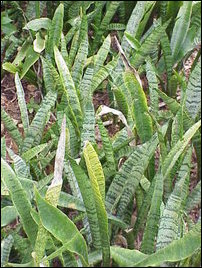
Kurumpai, Perung-kurumpai: Sansevieria zeylanica [Image courtesy: Wikimedia Commons]
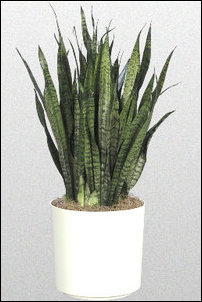
Kurumpai, Perung-kurumpai: Sasevieria zeylanica grown as a garden plant [Image courtesy: naturalsettingsanddesign.com]
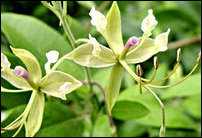
Veezhi or Vizhuthi: Cadaba indica or Indian Cadaba. [Image courtesy: indianetzone.com]
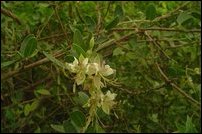
Veezhi or Vizhuthi: Cadaba indica or Indian Cadaba. [Image courtesy: indianetzone.com]

Veezhi or Vizhuthi: Cadaba indica [Image courtesy: Linnean herborium, Swedish Museum of Natural History, linnaeus.nrm.se]

Veezhi or Vizhuthi: Cadaba indica flowers [Image courtesy: Linnean herborium, Swedish Museum of Natural History, linnaeus.nrm.se]
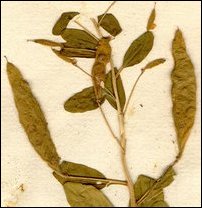
Veezhi or Vizhuthi: Cadaba indica fruits [Image courtesy: Linnean herborium, Swedish Museum of Natural History, linnaeus.nrm.se]
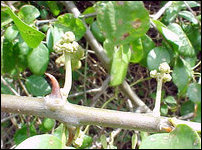
Thu’raddai, Thu’raddi: Pisonia aculeate. Note the hook-like thorn. [Image courtesy: cybertruffle.org.uk]
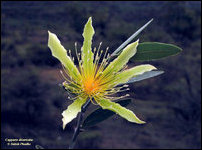
Thu'raddai, Thu'raddi: Capparis divaricata. Note the hook-like thorn [Image courtesy: Satish Phadke, Wikimedia Commons]

Another plant of the capparis family: Capparis zeylenica. Note the hook-like thorn. [Image courtesy Wikimedia Commons]
Coming to the prefixes of the place names of the column,
Kurumpa-chiddi most probably got the name from the Kurumpai hemp, known in English as the Bowstring Hemp and botanically termed as Sansevieria zeylanica.
This is stem-less and is a sort of creeping plant from the fibres of which bowstrings were made in the past. The plant is native to the island of Sri Lanka as could be seen from the botanical name zeylanica for the species.
The name Kurumpai for the hemp is of Dravidian etymology and is listed in the Dravidian Etymological Dictionary 1792. The plant is called Kurumpa in Malayalam. Perung-Kurumpai (the big Kurumpai) is another Tamil name for this plant or for a variety of it. Moorvaa and Niyanda are Sinhala names of the plant.
Another set of words, Kurumpai and Kurumpaddi in Tamil, and Kurumbaava and Kurumbætta in Sinhala - both of Dravidian etymology (DED 1791), popularly mean tender coconut or very young stage of coconut (also the young stage of the fruit of palmyra palm in Tamil). However, these words meaning only a stage of the fruit are not meaningful to the toponym, Kurumpa-chiddi.
There was another interpretation that the place name might have come from the tribe of Ku’rumpar. But, the presence of this South Indian tribe in Jaffna is not known from any records.
In the linguistic practices of Jaffna (as found in extreme south of Tamil Nadu), while it is common for a soft R to become a hard ‘R, it is very uncommon for a hard ‘R as in Ku’rumpar to become the soft R as in Kurumpa-chiddi.
The suffixes Chiddi, piddi etc., meaning a high ground or mound, originally stood for a very small locality, and their place name prefixes were usually associated with the flora or land features of the locality. They rarely come in association with terms for the settlements of communities.
If the locality becomes popular or dominant for any reason, the locality name will become the name of the village.
Mr. Jegatheeswaran Iyathurai, a native of Kurumpa-chiddi now residing in Toronto, Canada, who has recently authored a book on that village, sent the following feedback:
“Kurumpa-chiddi was originally the name of the plot of land located in the south east corner of the Chiththi Vinaayakar temple. In the 1910s, this plot served as grounds for the performance of the traditional theatre called Kooththu. The performance used to continue for many weeks. This locality is more commonly referred to as Iluppaiyadi. The plant Kurumpai, discussed in this column is found growing wild in this locality. I have seen the aforementioned plant at the edge of this locality and in the surrounding areas. But, the majority of the public is unaware of its name. In the land deeds the name of the locality was reportedly written as Kurumpariddi. It is not likely that until the 20th century the locality name was popular enough to become the name of the large village known by that name today”. (See discussion on Kurumpaaddi below)
Another reader, Mr. V. Srikathirgamanathan of Maathakal, now living in Denmark, also confirmed seeing this plant in the natural vegetation of Kurumpa-chiddi and further said that he had heard from elders about the economic use of such plants in making smooth and strong ropes for some specific purposes like the one that is put through the nose of a bullock as a curb (Mookka’naang-kayi’ru).
Note that in the distant past the fibre of the plant was a very valuable commodity as it was used in making strings for bows. Another English name, ‘mother-in-law’s tongue’ for the plant, humorously marks the strength of its fibre and sharpness of its tips.
* * *The plant that most probably gave the name to
Vizhi-chiddi must be Veezhi, which is a medicinal herb known by the botanical terms Cadaba indica or Cadaba fruticosa. Vizhuthi is another Tamil name of this plant.
The name
Vizhitheeddi (Vizhuthi-iddi), found as an alternative in a 19th or early 20th century literature on the local deity Vairavar, means the same as Vizhi-chiddi, and also evidences that Chiddi and Iddi are interchangeable terms in usage.
Veezhi or Vizhuthi is a staggering plant with simple oblong leaves and greenish flowers and must have got the name from its staggering nature. Veezhi means one that falls down. The verb root Veezh in Tamil (DED 5431) means 'to fall down', and some plants or parts of them having the nature of falling down have gained names connected to the root word Veezh.
Vizhal being the name of some grasses of falling type, Andropogon muricatus in Tamil and Erycibe paniculata in Malayalam, Veezh and Vizhuthu being the aerial roots of trees such as the banyan and Veezhith-thaazhai being a name for coconut palm are some other examples.
The deduction that Vizhi-chiddi got the toponym from the herb Veezhi is also strengthened by the examples of two other place names, one in Jaffna Peninsula itself and the other in Tamil Nadu.
Veezhu-pazhai is a locality name having a Ka'n'nakai temple in Ezhthumadduvaa'l in Pachchilaippa'l'li. The place name probably means the pond of Veezhi herb.
Veezhi-mizhalai or
Thiru-veezhi-mizhalai is a historical place in the Mizhalai division of the Chola country that probably got the name from the plant.
Apart from its many other medicinal uses the Veezhi herb is applied in treating blocks in the womb.
* * *The prefix Thu'raddai of the place name
Thu'raddaiyiddi (Thu'raddai-iddi) comes from the name of a wild shrub that has crooked thorns like a Thuraddi or Thuradu.
Thu'raddi and Thu'radu are Dravidian / Tamil words that mean a crook, hook etc. In Old Kannada the cognate is Tho'radu (Dravidian Etymological Dictionary 3366).
Two or more shrubs that have crooked thorns are known by the name Thu'raddai or Thuraddi: Pisonia aculeata and Capparis divericata. The fruit of one of them is known as Thu'raddip-pazham.
* * *Kurumpa-chiddi is a large and well-known village in the Valikaamam North division of Jaffna district. Kurumpa-chiddi was originally the name of only a small locality within the large village called by that name today. There is another place name in Puloali, Vadamaraadchi, which is also often pronounced very similar to Kurumpa-chiddi. (See Kurumpaaddi under related place names).
Vizhi-chiddi is a locality between Kollan-kaladdi and Pannaalai in the Valikaamam North division of Jaffna district.
Thu'raddai-iddi is a locality in the Kadduvan village, close to Mayiliddi in the Valikaamam North division of Jaffna district.
All the three places are deprived of their people as they come under High Security Zone and are occupied by Sri Lanka's armed forces.
* * *Some related place names:
Iddi: Mayiliddi: Mayil-iddi: The high ground or rising ground of Mayilai (bauhinia racemosa) shrub. This is a coastal village in Valikaamam North of Jaffna District. (See
Mayilagasthidar)
Kiraayiddi: Kiraay-iddi: The high ground or rising ground of grass and hard earth. This is a locality in A'laveddi North of Valikaamam North of Jaffna District. (See
Kiraay, Kiraan, Kiraagnchi)
Thaiyiddi: Thai-iddi: The place name has to be compared with
Maasiyappiddi or
Maahiyappiddi of Kantharodai and
Pangkunippiddi of Vara'ni. The prefixes are names of months. Thaiyiddi is a village between Kaankeasanthu'rai and Mayiliddi in Valikaamam North of Jaffna District.
Poyiddi: Poy-iddi: The high ground or rising ground of hollows or sinkholes. There are two localities with this place name: one near the Kaankeasanthu'rai cement factory and the other in Achche'lu, near Palaaly. Both places are in Valikaamam North of Jaffna District and both are in the terrain of limestone outcrops that is known for hollows or sinkholes exposing limestone caverns. Poy, from the root verb Po, is listed as a Dravidian word (Dravidian Etymological Dictionary 4452), meaning (as noun) tubularity, hole, hollow or recess in a tree; and (as verb) to be hollowed. The derivates Poku (as verb) means to make a hole, perforate, etc; Pokka'nai (as noun) means hole in a tree, stone, or ground, cleft in rock; Pokku (as noun) means hollow in a tree, defect, fault, blemish; Pokkai as noun means little hole; Pokkai-vaay means toothless mouth and Pokku'l is the little hole in the naval. Poykai > Poy-kayam is natural spring or pond in Tamil and the word is of Dravidian etymology (it has cognates in other Dravidian languages too, DED 4533). The etymology discussed above also shows that Pokka'nai in Eezham Tamil for waterholes and Pokku'na in Sinhala for small natural or artificial pond or cistern are most probably of Dravidian origin and not of Sanskrit Pushkara'ni.
Kurumpaaddi: Kurumpai-iddi: Means the same as Kurumpa-chiddi: The high ground or rising ground of Kurumpai hemp. This is a locality in Puloali South of Vadamaraadchi, Jaffna. The place name is sometimes pronounced as Kurumpa-hiddi, showing how the initial consonant P > H > S /CH could be lost for the word to become Iddi.
Inparuddi / Inpariddi /Impiliddi: Inpar-iddi or Impu / Impi /Impil-iddi: Most probably means the high ground or rising ground of Impooral (Impu-oo'ral) a kind of Chaaya-vear (indigo) plant. In the past, Jaffna was famous for many species of indigo and there was a flourishing industry of dying. The locality is close to Point Pedro, along the northern coast of Jaffna Peninsula.
Iddaa-vil: The pond of the rising ground. This is a place in Mukamaalai in Pachchilaippa'l'li of Jaffna Peninsula.
* * *Chiddi: Veema-chiddi: The high ground or rising ground, probably named after a person Veemaa. This is a sub-locality in Vizhi-chiddi, where the temple of Sivakurunaathaswami is located.
Thampa-chiddi: The high ground or rising ground of Thampai shrub or tree. This is a locality of Puloaly village of Point Pedro, along the northern coast of Jaffna Peninsula. The vegetation that gave the name to the place is either Thampalai (Nila-ilanthai), a kind of jujube or Thampanai (Mischodon zelanicus)
Kayaththa-chiddi: The high ground or rising ground of the pond (Kayam – pond, DED 1251). This is a locality in Kaithadi of Thenmaraadchi division of Jaffna district.
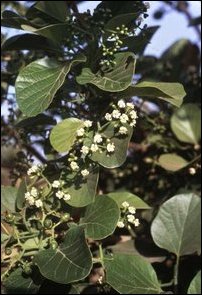
Loalai or Loala: Cordia myxa [Image courtesy: Fleurs d’Afrique tropicale et fleurs d’Europe]
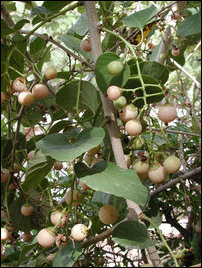
Loalai or loala: Cordia myxa, fruits [Image courtesy: Campus Arboretum, The University of Arizona]
Probably the high ground or rising ground having Loalai or Loala trees (Sinhala, Cordia myxa). This is a locality in Araali West of the Valikaamam West Division of Jaffna District. Loalai is tree of East African origin.
Ku'laththa-chiddi: The high ground or rising ground adjacent to the pond. This is a locality in Thaavadi, which is near the Nanthaavil pond in Valikaamam South division of Jaffna District.
Chiddi-puram: Also called
Chuddi-puram: The place of high ground or rising ground. This is a locality in Vara'ni, Thenmaraadchi, Jaffna. In this place, in a sub-locality called Eyp-pan'rik-kaadu (the jungle of porcupines), there is a Ka'n'nakai temple.
* * *Thiddi, Thidar: Kannaa-thiddi: The high ground or rising ground settled by Kannaar (coppersmiths) community. This is a locality in Jaffna city, in front of the Va'n'naarpa'n'nai Vaiththeeswaran temple.
Mayala-gas-thidar: The higher land or rising ground of Mayilai (Bauhinia Racemosa) shrub. This is a place in Ampaa'rai district. See column on
Mayilagasthidar.
* * *Piddi, Puddi: (the form colloquially used often is
Puddi)
Udup-piddi: The high ground or rising ground of Udai (Acacia) shrub. This is a large village in Vadamaraadchi division of Jaffna district.
Ku'lap-piddi: The high ground or rising ground adjacent to the pond. This is a locality at the southwest bank of the Nanthaavil pond, between Kokkuvil and Thaavadi in Jaffna Peninsula.

As in the place names of Maldives, Puddi or Piddi also means an islet in Eezham Tamil, as it is a rising land above the sea. Note the tiny islet called Ka’n’naa-puddi between the Ku’rikaadduvaan islet and the main island of Pungkudutheevu [Image courtesy: Google Earth]
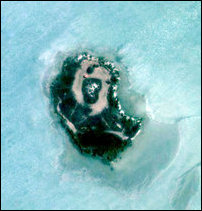
The islet Ka’n’naap-puddi off Pungkudutheevu [Image courtesy: Google Earth]
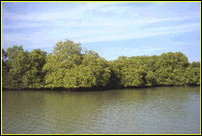
Avicennia marina, the widely found mangrove known in Tamil as Ka’n’naa or Ve’n-ka’ndal [Image courtesy: Forest Department, Nagapattinam]
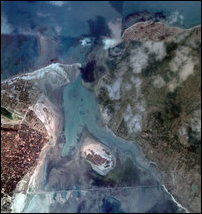
Another example for an islet being called by the name Piddi: Thuruthip-piddi or Thuruththip-piddi islet between Kaarainakar Island and Punnaalai in the Jaffna Peninsula. Also note the growing sandbank Thoompil-piddi on the north of it. [Image courtesy: Google Earth]
The islet of Ka'n'naa mangrove. This is a tiny islet west of Pungkudutheevu off Jaffna Peninsula, near Ku'rikadduvaan. Note the spelling Puddi in this instance. The Ka'n'naa mangrove shrub (Avicennia marina) is also called Ve'n-ka'ndal in Tamil. It is known as Ma'nda in Sinhala.
Thuruthup-piddi: Also called
Thuruthip-piddi: The islet in the channel. This is an islet located at the entrance channel between Palk Bay and Jaffna Lagoon (the channel between Kaarainakar island and Punnaalai in the peninsula). In fact the word Thuruththi itself means an islet in a river, lagoon etc.
Thoompil-piddi: The sandbar of the channel. This is a sandbank stretching from the northeast corner of the Kaarainakar Island and extending across the channel that links the Jaffna Lagoon and the Palk Bay. Thoompu in Tamil means a channel or an opening, pipeline etc, through which water flows.
Karaiyaam-piddi: The mound at the coast. This is a locality having mounds amidst paddy fields, adjacent to the lagoon front near Kaakkai-theevu in Aanaikkoaddai.
Papparavap-puddi: The rising seashore having a settlement of Papparavar community (See column on
Papparavap-puddi). This is a place near Chaalai of Mullaiththeevu District.
Kat-piddi / Kal-pitiya: The rocky higher land or rising ground. This is a place at the tip of the Kat-piddi Peninsula in the Puththa'lam District of Northwest Province.
Pulladi-puddi: The rising ground or a mound in the locality of the grassland. This is a locality south of Ninthaavoor in Batticaloa district. This is one of the rare occurrences of the suffix and its cognates in the Eastern Province.
* * *Pitiya (Sinhala):
Ku'liyap-pitiya: The high ground or rising ground of the pond or waterhole (Kuzhi: pond, waterhole in Tamil). This is a place in Kurunagala District of Northwest Province.
Divula-pitiya: The high ground or rising ground of Divul (wood apple) trees. This is a place in Gampaha District of Western Province.
Piti-pana: This is the tip of the sandbar near Negombo, at the entrance of the lagoon.
Dalu-pitiya: The high ground or rising ground of the thorny Daluk tree (Euphorbia antiquorum). Another possible meaning is the higher ground / rising ground of betel. (Dalu, meaning young leaves and betel, is the Sinhala cognate of Tamil Tha'lir, meaning young leaves). This is a place in Wattala division of Gampaha District, Western Province.
Kampurup-pitiya: The high ground or rising ground variegated in the colour of the earth. This is a place in Matara District of Southern Province.
Kumpu'rup-piddi / Kumburup-pitiya: The rising ground or a mound, situated amidst or adjacent to a stretch of paddy fields. Kumbura as singular and Kumburu as plural mean paddy field in Sinhala. The word is a cognate of Old Tamil, Kampalai, (Dravidian Etymological Dictionary 1237) which means an agricultural tract of land (A > U and L > R). Kumpu'rup-piddi is found in several places in the island. In Tamil areas one such is noticed north of Nilaave'li in Trincomalee and another is found in the Kayts Island off Jaffna Peninsula.
Tuttirip-pitiya: The high ground or rising ground of common grass (Crysopogon aciculatus). This is a place in Kalutara District of Western Province.
Bala-pitiya: The rising ground having a cave, or the rising ground having the Bala trees (Nothopegia colebrookiana). This is a town in the Western coast of Galle District in the Southern Province.
Kollu-pitiya: From
Kozhu-piddi / Ko'lu-piti: The high ground or rising land near the Kozhu / Ko'lu or point. The place is part of today's Colombo city and is located immediately adjacent to the tip part of the landscape and the heart of the city. The tip, Kozhu, Kozhumpu or Ko'lumpu was the original landscape that got the colonial name Colombo, and the colonial rendering for the adjacent rising ground Kozhu-piddi was Colpiti. When the etymology was lost to the present population of Colombo, it became Kollu-pitiya and in turn become Tamilized as Ko'l'lup-piddi. See column on
Colombo.
* * *Puti (Dhivehi / Maldivian):
Many island names ending with Puti in the copper plate inscriptions of 12th-14th century Dhivehi / Maldivian have become Fushi (singular Futtaa) today. Some of the examples of the old names of the Maldives Islands from the copper plate texts are given here. The present names and their locations are given within brackets along with meaning and possible equivalents in other languages. (Source: Ponnampalam Ragupathy, An Etymological Dictionary of Maldivian Island Names, National Centre for Linguistic and Historical Research, Male, 2008). Read, LH in the names as 'L and T in its retroflex sound equivalent to D in Tamil words.
Bilhala-puti (Bulhala-fushi, Kolhumadulu atoll, The island at the entrance; Tamil equivalent: Puzhai-puddi)
Donun-puti (Dhonan-fushi, Kolhumadulu atoll, The island of boats; Tamil equivalent: Thoa'ni-puddi)
Eliveli-puti (Olhu-veli-fushi, Faadhippolhu atoll, The island of marsh and sands; Old Tamil equivalent: A'luvam – marshland; Vaal –white sand; Sinhala: Wæli- sand, gravel)
Galu-puti (Gaa-fushi, Thiladhunmathi North atoll, The rocky island; Tamil equivalent: Kal-puddi)
Gasethi-puti (Gaathu-fushi, Ari North atoll, The island close by; equivalents Kannada: Hathira – close; Sinhala: Gaavaa – nearby; Old Tamil: Kavavu: close embrace, closely attached)
Kelhi-dhevee-puti (Kalhudhey-fushi, Kolhumadulu atoll, The island of dark spirits; Sinhala equivalent: Ka'lu-devi-pitiya)
Kolhi-puti (Kolhu-fushi, Kolhumadulu atoll, The tip island; Tamil equivalent: Kozhu-puddi; see column on
Colombo)
Medu-puti (Medhu-fushi, Kolhumadulu atoll, The middle island; Sinhala equivalent: Mæda-pitiya)
Munna-puti (Munya-fushi, Hadhdhunmathi atoll, The island at the forefront; Tamil equivalent: Mun-puddi, Munai-puddi)
Vilu-puti (Vilu-fushi, Kolhumadulu atoll, The island of deep lagoon; Eezham Tamil equivalent: Vil-puddi; Vil, Villu: pond in Eezham Tamil; Vila means the same in Sinhala; see column on
Vilpattu)
* * *Huti / Huttaa / futtaa / Muttaa (Maldivian Dialectal Forms for
Fushi):
These are dialectal forms of Maldivian island names found especially in the Huvadhu atoll, which is a southern atoll of the archipelago:
Aakiraa-huttaa: (Huvadhu South atoll), The island of coral aggregate (Tamil equivalent: A:hka-puddi)
Babaraa-huttaa: (Huvadhu North), The island haunted by a dark spirit looking like a Negro boy (Tamil equivalent: Papparavan-puddi. See
column under this name)
Beyru-huttaa: (Huvadhu North), The island lying outside (Tamil equivalent: Vea'ru-puddi)
Bode-huttaa: (Huvadhu), The big island (Tamil, Peedu: great; Hindi, Badaa: big)
Fara-kolhu-huttaa: (Huvadhu South), the island at the tip of the reef (Tamil equivalent: Paarai-ko'lu-puddi)
Kuda-futtaa: (Huvadhu North), The small island (Kuda: small – Sinhala and Tamil; equivalent in Tamil: Kuddi-puddi)
Maa-muttaa: (Huvadhu North), The big island. The word Muttaa in this instance clearly corresponds to the cognates of Meadu, listed under DED 5058 (see table).
* * *Chuddi, Chuddaan: Chuddi-puram in Thenmaraadchi, Jaffna,
Chuddaap-piddi, Oddi-chuddan, Pa'ndi-chuddaan, Keeri-chuddaan and
Kuzhavi-chuddaan in Vanni are some of the examples. They will be discussed in a subsequent column.
First published: Friday, 23 July 2010, 21:53
Previous columns:






















